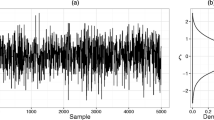Abstract
The identifiability of item response models with nonparametrically specified item characteristic curves is considered. Strict identifiability is achieved, with a fixed latent trait distribution, when only a single set of item characteristic curves can possibly generate the manifest distribution of the item responses. When item characteristic curves belong to a very general class, this property cannot be achieved. However, for assessments with many items, it is shown that all models for the manifest distribution have item characteristic curves that are very near one another and pointwise differences between them converge to zero at all values of the latent trait as the number of items increases. An upper bound for the rate at which this convergence takes place is given. The main result provides theoretical support to the practice of nonparametric item response modeling, by showing that models for long assessments have the property of asymptotic identifiability.
Similar content being viewed by others
References
de Leeuw, J., & Verhelst, N. (1986). Maximum likelihood estimation in generalized Rasch models.Journal of Educational and Behavioral Statistics, 11, 183–196.
Douglas, J. (1997). Joint consistency of nonparametric item characteristic curve and ability estimation.Psychometrika, 62, 7–28.
Junker, B., & Ellis, J. (1997). A characterization of monotone unidimensional latent variable models.The Annals of Statistics, 25, 1327–1343.
Hoeffding, W., (1963). Probability inequalities for sums of bounded random variables.Journal of the American Statistical Association, 19, 293–325.
Mikhailov, V.G. (1995). On a refinement of the central limit theorem for sums of independent random indicators.Theory of Probability and its Applications, 38, 479–489.
Mokken, R., & Lewis, C. (1982). A nonparametric approach to the analysis of dichotomous item responses.Applied Psychological Measurement, 6, 417–430.
Ramsay, J.O. (1991). Kernel smoothing approaches to nonparametric item characteristic curve estimation.Psychometrika, 56, 611–630.
Ramsay, J.O., & Abrahamowicz, M. (1989). Binomial regression with monotone splines: A psychometric application.Journal of the American Statistical Association, 84, 906–915.
Samejima, F. (1979).A new family of models for the multiple-choice item (Research Rep. No. 79-4). Knoxville, TN: University of Tennessee, Department of Psychology.
Samejima, F. (1981). Efficient methods of estimating the operating characteristic of item response categories and challenge to a new model for the multiple-choice item. Unpublished manuscript. University of Tennessee, Department of Psychology, Knoxville, TN.
Samejima, F. (1984).Plausibility functions of the Iowa Vocabulary Test items estimated by the simple sum procedure of the conditional P.D.F. approach (Research Rep. No. 84-1). Knoxville, TN: University of Tennessee, Department of Psychology.
Samejima, F. (1988).Advancement of latent trait theory (Research Rep. No. 79-4). Knoxville, TN: University of Tennessee, Department of Psychology.
Samejima, F. (1990).Differential weight procedure of the conditional p.d.f. approach for estimating the operating characteristic of discrete item responses (ONR Research Rep. No. 90-4). Knoxville, TN: University of Tennessee, Department of Psychology.
Sijtsma, K. (1998). Methodology review: Nonparametric IRT approaches to the analysis of dichotomous item scores.Applied Psychological Measurement, 22, 3–31.
Sijtsma, K., & Molenaar, I. (1987). Reliability of test scores in nonparametric item response theory.Psychometrika, 52, 79–97.
Stout, W. (1987). A nonparametric approach for assessing latent trait unidimensionality.Psychometrika, 52, 589–617.
Author information
Authors and Affiliations
Corresponding author
Additional information
The research was partially supported by the National Institute of Health grant R01 CA81068-01.
Rights and permissions
About this article
Cite this article
Douglas, J.A. Asymptotic identifiability of nonparametric item response models. Psychometrika 66, 531–540 (2001). https://doi.org/10.1007/BF02296194
Received:
Revised:
Issue Date:
DOI: https://doi.org/10.1007/BF02296194




